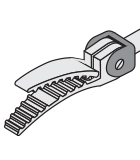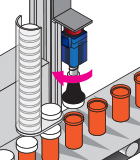Overview|Technical Documents|Specifications|Applications
Ultra-Low-Power Miniaturized Integrable Sampling System.
QIA128 , Ultra-Low-Power Miniaturized Strain Gauge Full Bridge mV/V Inputs to Digital Breakout Board with Solder Tabs to 9 Pin SPI and UART Output
Listed price is in U.S. currency and subject to verification along with availability
Description
QIA128 is a miniature embedded sampling system for load cells with ultra low power consumption of only 60 mW. It is capable of sampling strain gauge signals up to 1300 samples per second (SPS) with up to 18.4 Bits of Noise Free Resolution (NFR). Check the spec sheet for Noise Free Resolution detailed table.
QIA128 is a signal conditioner compatible with strain gauge bridge resistance ranging from 350 Ω to 5000 Ω. This miniaturized integrable sampling system comes in a ultra small package of 8 mm x 8 mm, which makes it ideal for medical devices or robotics applications where assembly space is a limiting design factor.
For multi channel load cell amplifier, visit QIA125 Digital Low Power Three Channel SPI Output.
UART vs. SPI output in Embedded Systems
UART is a widely-used serial communication protocol known for its simplicity and suitability for long-distance communication. It operates asynchronously, making it ideal for connecting load cells to microcontrollers or computers, enabling precise data transmission over extended distances without synchronized clocks. On the other hand, SPI is a synchronous communication protocol preferred for high-speed communication between chips or connecting multiple devices over short distances. It is efficient and low-overhead, making it ideal for applications like load cell signal conditioning. The choice between UART and SPI depends on specific system requirements, with SPI offering higher-speed communication over shorter distances, while UART is better suited for longer-distance applications. For more detailed information on UART and SPI in embedded systems, you can refer to this technical article - "UART And SPI In Embedded Systems"
Features
- mV/V Input Solder Tabs
- 6 ft Long Power/Output Cable
Technical Documents
Resolution Calculator
Product Features
Specifications
| CHANNEL | MIN | TYP | MAX | UNIT |
|---|
Applications
All other trademarks, service marks and logos used in this website are the property of their respective owners.
© 1998–2025 FUTEK Advanced Sensor Technology, Inc. All rights reserved.
+
+
19 Morgan, Irvine,
CA 92618 USA
CA 92618 USA
All other trademarks, service marks and logos used in this website are the property of their respective owners.
© 1998–2025 FUTEK Advanced Sensor Technology, Inc. All rights reserved.























